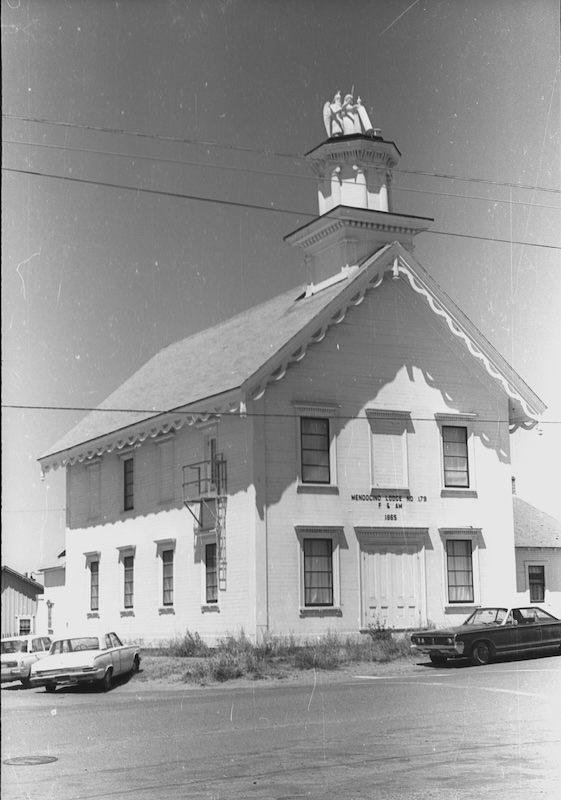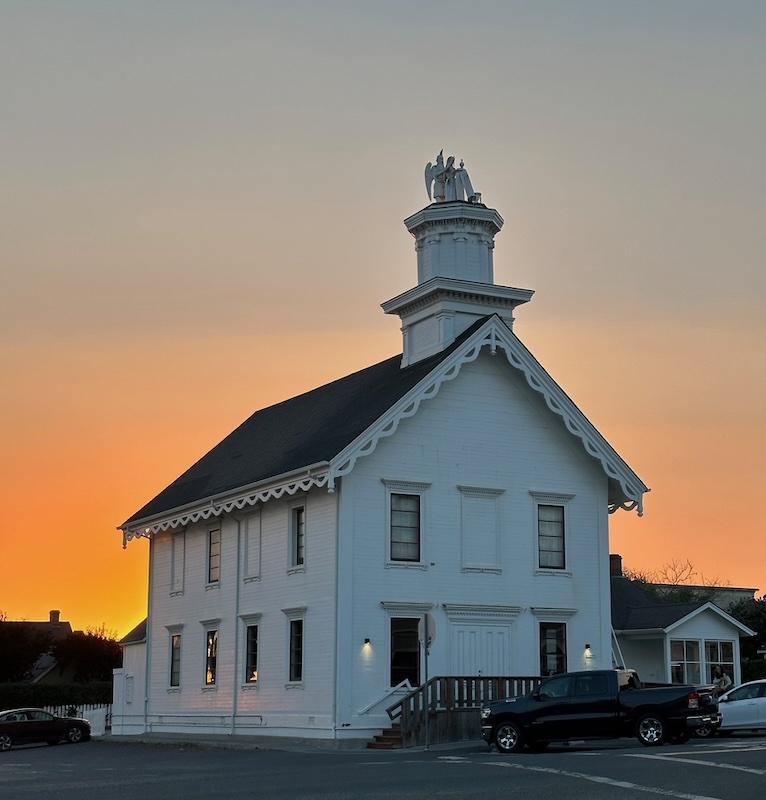
Mendocino Masonic Hall, c. 1960.
These two photographs, taken about 65 years apart, show the Masonic Hall located on the northwest corner of Lansing and Ukiah Streets in Mendocino. This historic structure, one of the oldest buildings still standing in town, was surveyed in May 1976 for the State Office of Historic Preservation by Kelley House Museum co-founder Beth Stebbins.
The Mendocino Masonic Lodge, No. 179, organized in 1865, is believed to be the oldest fraternal organization in continuous existence on the Mendocino Coast. Initially, the Masons met in a private room above William Heeser’s General Store, but plans to build their own temple began almost immediately.
Heeser, the first Senior Warden and Secretary of the lodge for many years, donated land for a permanent meeting hall. In February 1866, Erick Albertson was awarded a $1,000 contract to construct the building. Albertson, a millworker and the lodge’s first Worshipful Master, collaborated with John Gschwend, an Anderson Valley sawmill operator known for his quality design work, to draw up plans for the building. Albertson crafted the interior’s elaborate ornamentation, including the curved barrel vault ceiling, carved fluted columns, arches, and ceiling decorations, all rich with Masonic symbolism. Construction took six years because the men also worked at the lumber mill; the total cost of the completed lodge was about $3,860.
Albertson also created the unique sculpture that adorns the top of the hall. Even before the lodge was organized, Albertson had begun hand-carving “Time and the Maiden” in his spare time, working at night by candlelight in a shack on the Big River beach. As the temple neared completion, lodge members agreed to add a cupola to the top of the building to display the statue.
Carved from a single block of redwood, the 10-foot tall figure depicts a bearded Father Time with wings and a scythe, standing behind a weeping maiden whose hair he is braiding or unbraiding. The maiden holds an acacia branch in her right hand and an urn in her left. She stands beside an hourglass and faces a broken column and an open book.

Mendocino Masonic Hall and Savings Bank of Mendocino County, 2024. (Photographer: Robert Dominy)
Each element conveys profound messages about life, death, and the passage of time. The hourglass reminds us of life’s fleeting nature, the urn and scythe signify the inevitability of death, and the broken column represents a life cut short. The weeping maiden embodies mourning, while the open book symbolizes the enduring record of the deceased’s accomplishments. The acacia branch, known for its resistance to decay, symbolizes the immortality of the soul. While the exact meaning of the statue remains a Masonic secret, a common interpretation is “Time, patience, and perseverance will accomplish all things.”
In 1976, the Mendocino Masonic Lodge sold the building to the Savings Bank of Mendocino County, retaining the right to use the upstairs lodge room as long as the lodge remains active. Since October 1977, the bank’s Mendocino branch has occupied the first floor of the hall. A one-story, 637 square-foot expansion was added to the northwest corner of the historic building in 1983.
The Kelley House Museum is open from 11AM to 3PM Thursday through Monday. To learn more about the Masonic Hall and other historical buildings in Mendocino, schedule a Walking Tour of the Historic District.